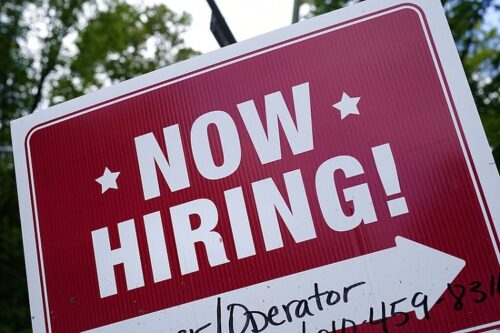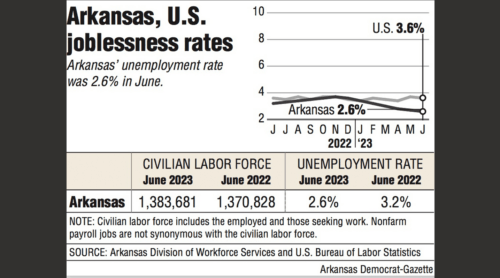
7.22.23 – NWA Online
Workforce participation up as joblessness drops in U.S
Arkansas’ unemployment rate declined to 2.6% in June, a record low, with the drop mirroring the national jobless rate.
That Arkansas rate dropped 0.1 percentage point since May and is lower than any in the state over the past two decades. Peak unemployment during the recession that began in 2007 was 8%, and it was the highest at 10.1% during the covid-19 recession, in April 2020.
The U.S. unemployment rate was 3.6% in June, also down 0.1 percentage point from last month.
Compared with June 2022, there are 21,415 more employed Arkansans and 8,562 fewer unemployed people. The state unemployment rate has decreased by 0.6 percentage point since then.
Month-to-month labor force participation increased 0.1 percentage point from May to June, to 57.6%, according to the data from the Arkansas Division of Workforce Services and the federal Bureau of Labor Statistics.
“It was stuck at 57.4% for six months,” said Arkansas Commerce Secretary Hugh McDonald. “I don’t see it as a result of state policy, just more people going back to work. That’s positive.”
Summarizing the economic picture, he said, “Continued positive trends moving in the right direction signals a strong economy. Twenty-one thousand more employed people in Arkansas in the last 12 months, 8,500 fewer unemployed Arkansans in the past 12 months — it’s just good all around.”
Industries with the largest month-to-month employment gains include health care and social assistance (2.9%); construction (1.9%); arts, entertainment and recreation (1.6%); and durable goods manufacturing (1.1%).
McDonald said “the majority of the impacts are happening in the big populated areas,” but that “pockets of strength” exist elsewhere, from planned steel plants in Osceola and Blytheville to a hopeful situation with lithium extraction in south Arkansas.
“The potential could be huge,” he said. “Proof is in the pudding with scaling up those businesses, but it’s certainly very positive right now.”
While Exxon Mobil declined comment about its reported plans for a lithium processing facility near Magnolia, an Arkansas Department of Energy and Environment spokeswoman said departmental “employees have had preliminary meetings with representatives of Exxon regarding what will be needed if they file permits to” drill test wells or construct a plan.
Certain state industries did see a decline in jobs from May to June: 0.1% in mining and logging; 0.1% in information services; 0.2% in food services; 0.4% in transportation, warehousing and utilities; and 1.5% in private educational services.
Jobs in two employment categories saw more notable declines: professional and business services, 2.7% and government, 6.9%.
Professional, scientific and technical services were down 0.6%, company management dropped 0.1%, and administrative and support services were down 1.1%
State government employment, meanwhile, declined 5% — 4.9% in education services and 0.1% in other services. Local government employment declined 2%, with a 3.3% reduction in education services jobs.
Twenty-two states have unemployment rates lower than the national figure. New Hampshire and South Dakota have the lowest rates in the country, 1.8%, and Nevada the highest at 5.4%.
Arkansas has a lower jobless rate than most of its neighboring states: 3.6% in Louisiana, 3.1% in Mississippi, 2.7% in Oklahoma, 3.2% in Tennessee and 4.1% in Texas. Missouri’s rate is also 2.6%.
“Arkansas’ got a pretty diversified economy,” McDonald said. “And on one side that’s a good thing with downturns, but when there’re major upturns — we don’t see the big peaks, we don’t see the big valleys.”

